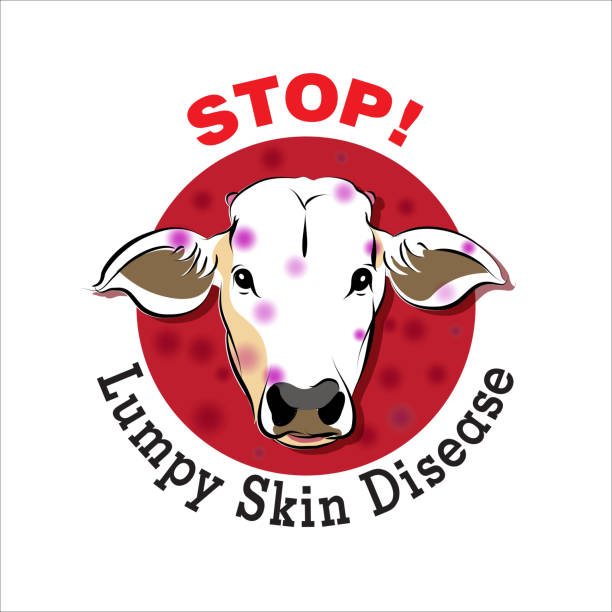GUIDELINES FOR PREVENTION OF LSD (LUMPY SKIN DISEASE)
Guidelines for prevention of Lumpy Skin Disease
Incidence/outbreaks of Lumpy Skin Disease (LSD) in cattle has been reported in states namely Gujarat, Rajasthan, Punjab, Uttarakhand and Himachal Pradesh. In order to prevent the spread/entry of LSD to other states/UTs, strict action and preparedness is required to be taken up by the Animal Husbandry Department of the states/UT bordering the above five states.
States/UTs are advised that requisite biosecurity measures be strictly enforced in letter and spirit so that the disease does not enter from the neighboring states/UTs. Further, States/UTs are requested to commence clinical surveillance wherever necessary so that suspected LSD cases could be confirmed from samples sent to ICAR-NIHSAD, Bhopa
Preventive measures
Further, following preventive measures as well as isolation of the affected animal should be implemented immediately, to prevent future LSD Incidences.
- Control of animal movement – In order to minimize the economic impact of the outbreaks and to control LSD, the movement of animals to and from the infected area and from affected states should be completely banned. This will check the transmission/spread of LSD.
- Restriction with affected animals and persons dealing with such animals – The movement of people to and from the affected area should be restricted. The animal handlers and those attending to the affected animals should be advised to keep away from healthy animals. It is, therefore, of utmost importance to ensure these safety measures.
- Vaccination:
- The infected villages are identified so that precautionary plans are carried out in a specific area and ring vaccination carried out in villages up to 5 km around the affected village.
- Cattle and buffaloes should be vaccinated with the available Goat pox vaccine (cattle and buffalo at the age of 4 months and above through the S/C route) with 103.5 TCID50 of GTPV vaccine (Uttarkashi strain). However, the dose of 103.0 TCID50 (same dose of vaccine for goat against goat pox) can be used for prophylactic vaccination/ring vaccination in cattle and buffalo.
- However, affected animals should not be vaccinated.
- Preventive vaccination should also be undertaken in high risk areas like border area of affected district and state and animals should be identified
and documente. - The staff and vaccinators should be trained for vaccination drive including storage and preparation of vaccine, dosing and injection and dentification of animals.
Bio-security measures
- Immediate isolation of sick animal from the healthy animals. Symptomatic treatment of affected animals may be carried out with all precautions and biosecurity measures. Feeding of liquid feed, soft feed and fodder is recommended.
- Clinical surveillance against LSD in affected districts and around surrounding villages should be intensified.
- The buffaloes should be kept separately till complete recovery of the affected animals, if reared together.
- Disinfection of premises at regular intervals.
- Ecto-parasiticide should also be applied to healthy animals on the infected and on surrounding farms.
- The persons dealing with the infected animal should wear gloves and face masks and carry out hygienic and disinfection measures at all times.
- Care should be taken to report any unusual sickness of other animals to the nearest veterinary Hospital/Dispensary.
- Hygiene practices should be followed at the animal farm and by the people in areas where animals are infected.
- Farms with affected animals should be visited regularly by field veterinarians until all the cases are recovered. The veterinary staff should take all precautionary hygiene measures to avoid the further spread of disease to other farms/households.
- In case of mortality, carcass should be disposed of by deep burial method observing all hygienic measures.
- Cattle markets located within 10 km radius of the epicentre of infection should be closed.
- Trade of live cattle, participation in fairs, and shows should be banned immediately upon confirmation of the disease in the affected areas.
- Semen from LSD-affected animals should not be collected and processed for production and distribution.
Vector control
- Control of vector population (ticks, flies, mosquitoes, fleas, midges) in the premises and the animal body should be carried out using insecticide, repellents and other chemical agents.
Disinfection and cleaning measures
Affected Premises, vehicles plying through the affected animal holdings should be carried out with appropriate chemicals/disinfectants [Ether (20%), chloroform, formalin (1%), phenol (2% /15 minutes), sodium hypochlorite (2- 3%), iodine compounds (1:33 dilution) and quaternary ammonium compounds (0.5%)].
Awareness programme
Mass awareness campaign to be taken up to make the public aware of the disease and report to the veterinary authority immediately when suspected cases are detected. This will help in prevention and control of LSD.
Regular training and sensitization of veterinarians including awareness to animal owners and other stake holders should be enhanced on clinical presentation of the disease along with surveillance strategy and control measures.
Animal Husbandry Department should maintain proper liaison with police and border agencies to check illegal entries of cattle from neighbouring countries (Wherever required).
Related suggestions
- Strict implementation of advisories
- Strict implementation of bio-security measures
- Movement restriction and isolation of affected animals
- Movement control of vehicle, animals from affected area to free area
- Disinfection measures to be followed strictly in liaison with Municipal bodies and administration including regular fogging and lime spray in the infected and surrounding area
- Stray animals to be monitored regularly and the affected animals should be isolated under veterinary care with the help of municipal and administrative
authorities - Waste disposal including feed, fodder and dead animal to be followed as per protocol and scientific method with marking and displayed safety guidelines
- Animal movement from affected area to be monitored to prevent spread of the infection
- Animal trade and fare should not be allowed in the affected area
- Vehicle passing through the infected area should be monitored and disinfected.
- Insecticides spray and fogging to be undertaken in the animal sheds, common grazing area, veterinary hospital and dispensaries, animal gathering spots and animal movement tracks to control vectors like mosquito, flies, ticks, fleas etc.
- Surveillance of vector should also be undertaken by sending the samples to ICAR-NIHSAD to understand disease epidemiology and accordingly making
control strategies. - Monitoring of pastures, grazing area, water bodies, feed and fodder to prevent contamination by infected animal
- Infected feed, fodder and bedding material should not be used and disposed scientifically
- Infected animals should be kept separately in isolation with close monitoring till recovered and should not be kept in same animal shed. The milk of infected animals should not be used and mixed in the milk of healthy animals
- Unnecessary post-mortem and sampling of infected animals should be avoided so that disease may not spread during such operations. The staff should wear all preventive gears during PM and sampling
- The sampling should be done as per the prescribed SOP and protocol with due care at all times and proper and safe transport shall be ensured. Sampling
should only be done by expert personnel by the veterinarian or under veterinary supervision - Except in unavoidable circumstances, the treatment of infected animal should be done through oral medication and topical application to avoid spreading of disease through treatment procedures and contamination of treatment accessories and personnel during treatment.
- The veterinary hospitals and dispensaries should have proper supply of medicines, supplements, disinfectants, treatment accessories, foggers, awareness material PPE kits and other related items at all times
- Control room and 24×7 toll free number to be activated to address the issues of farmers immediately and also awareness.
- Role of MVUs should be increased in awareness, treatment and vaccination drive and the MVU operating in infected area should not enter the free area and if required proper disinfection protocol should be followed
- Door to door awareness and vaccination drive should be undertaken with the help of NGOs, village leaders, youths, cooperatives, school teachers and other stakeholders
- Milk collection centers should educate the farmers at the time of milk collection and ensure healthy milk collection without mixing of the milk of infected animals. The consumption and transport of raw milk of infected animal should be discouraged
- Group grazing area and animal groups should be monitored and vaccinated and the infected animals should be immediately separated and kept under isolation under veterinary care. Special care should be taken to monitor the movement of animals from affected districts and states and round the clock check post with disinfection system should be activated and documented
- Veterinarians and para-veterinarians working in the infected zone should not be deputed for other works so that their services are available round the clock and they can contribute effectively in disease control programme.
- Proper TA/DA and incentives should be given and announced for veterinarians, para-veterinarians and other staff to motivate them in disease control operations.

GUIDELINES FOR PREVENTION OF LSD (LUMPY SKIN DISEASE)


